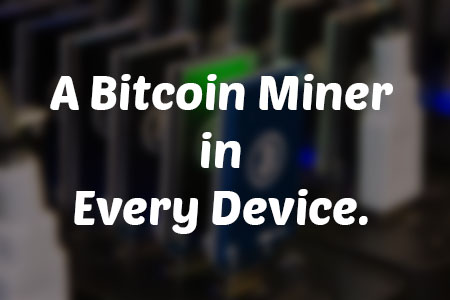
It seems everyone is getting caught up on the mining chip and how it’s not power efficient and won’t be profitable for consumers or 21.co
That’s probably true, but it seems to be a loss-leader for creating & owning the payment infrastructure of the future.
Bitcoin is an ideal currency – but there isn’t really an ‘ideal payment network’ yet, especially as the IoT grows.
So, chips go on devices. Maybe they only turn on when your device is plugged in.
Phones are one option, but others could be refrigerators, stoves, fire alarms, cars, street lights, bus stops, drones, real estate (rooftops), etc.
The devices plugged in at any given time create a mesh network which allow information (transactions) to be quickly verified across many local, distributed nodes.
When one device interacts with the network, it sends a small ~3 satoshi transaction to authenticate or enter a smart contract with another device.
For example, a car interacting with a parking meter.
The computing resources needed to verify the transaction are sourced from other devices on the mesh network, and they would be rewarded with a small fee (2 satoshi).
This means mining the blockchain is only one way these devices can make satoshi’s.
Priority of transaction verification is another.
The purpose of mining in the system is to give devices a constant flow of ‘tokens’ which they can use to enter smart contracts, etc.
I don’t think the intention of mining is to make every device a profit-generating machine.
It seems the goal is to make ‘enough’ satoshis to enable devices to talk to each other and record their interactions on the blockchain.
So there are really two sides to what transaction can mean on the bitcoin network.
The first is buying something with a ‘real’ amount of bitcoin. That’s a typical transaction for a service or product.
The second is authenticating // recording information in the block chain through a ‘virtually valueless’ amount of bitcoin.
1 satoshi is 0.00000001 BTC, so these transactions don’t cost ‘money’, but they are still valuable in a sense that we can record some piece of information and verify it in the blockchain forever without the chance of that record being altered in any way.
—————
The real money-maker in my eyes, would be the API layer that 21.co is building alongside their chip network.
When all these devices are transacting, verifying, prioritizing — all of these mechanics are decided by whoever owns the infrastructure.
Bitcoin is a decentralized currency – a store of value – but it is not a payment network.
Imagine the value of x% of EVERY transaction happening in our daily lives. Big and small.
From advertising, to parking spaces, to buying @usernames, to purchasing homes. All happening seamlessly.
This also wouldn’t be industry specific – it would literally be all transactions that happen between humans & machines.
One crazy example:
Advertisements could exist in the physical world, like a billboard, and have a chip on it.
When you walk into range of a device, you could opt-in and receive + $3.00 to have the ad displayed, or have no advertisement show.
This would be one way to reverse advertising — where instead of paying a network like Facebook, you pay the people you’re advertising to.
Now the question is, how does this happen without annoying you, the end user?
That’s where the cool part of these seamless micro transactions come in.
Let’s say you put an ‘open bounty’ on the block chain to all advertisers – when you’re in range of an ad (10 feet), you will opt-in for $3.00 (.000x BTC)
Now that this information is recorded in the block chain – when you come into range, the devices can then talk to each other and authenticate by sending a small micro-satoshi transaction. They will decide which advertiser gets to serve their content based on the highest bid, enter a smart contract, and the advertisement will be served if your terms are matched.
Now, lets say advertiser #1 is only willing to pay $2.50 for the ad space – in this scenario it could either default down to another advertiser willing to pay your minimum of $3.00, or no ad would be served.
All the details could be stored and recorded in the blockchain – and the ‘computers’ can figure out if a deal can be made based on our mutual settings.
To give another analogy – its kinda like tinder of the future. You’re walking down the street, your profile is already filled out – and you simply walk past a girl and get a notification on your phone saying ‘match!’. Seamless & efficient. Also a little weird, but we’ll get used to it.
Although the ‘reverse advertising’ is kind of a wacky, futuristic implementation, I think it gets the point across of devices ‘transacting’ with each other seamlessly, in real time – then coming to terms and entering an agreement all without human interaction.
This enables some really cool interactions and mechanics that we haven’t really seen before.
To jump back to the chips & mining — in order for these transactions to process / verify in real time, a mesh network with multiple, distributed nodes would probably be ideal.
———–
Where else is value?
The data.
These chips will be able to collect tons of data – location of transaction, time, merchant history, buyer history, etc.
Also, depending on how the hardware is implemented, the 21.CO chip may also pull additional data from the devices own sensors.
When a btc transaction is made, it’s unlikely that much of the additional data collected will be sent along to the blockchain.
So even though the transactions are public on the block chain – there is still tons of valuable data around a transaction, who / what / where / when, and when you put together with millions of other transactions, it gives you an interesting and very valuable look into where money is flowing, where people are moving, and how to place your bets in the future.
Imagine you’re an investor and you could see, in real time, where money is flowing in the economy. A real time breakdown of how much people spend on X Y Z, and the percentage of change over time.
That’s pretty tight.
– J

